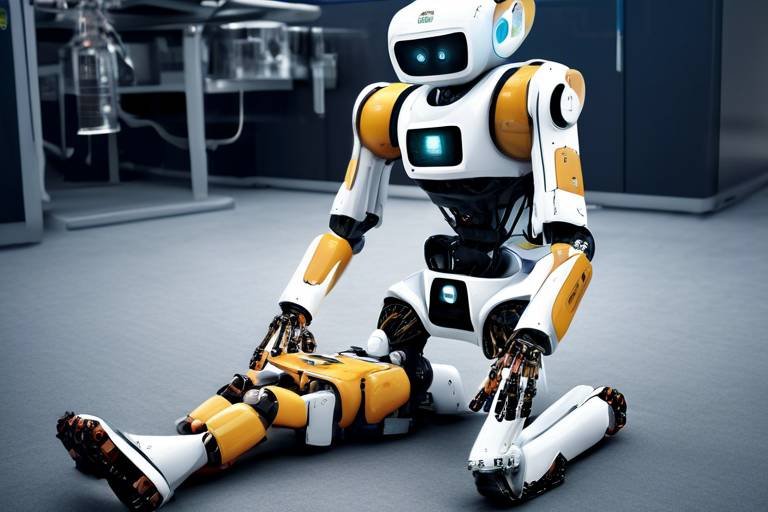How Robotics is Improving Supply Chain Management
In today's fast-paced world, the supply chain is the backbone of any successful business, and robotics is revolutionizing this critical sector. Imagine a well-oiled machine where every cog works in harmony to deliver products to customers faster and more efficiently than ever before. That's the power of robotics in supply chain management! From warehouses to transportation, robotics technology is making waves, enhancing efficiency, reducing costs, and improving accuracy. But what does this all mean for businesses and consumers alike? Let's dive deeper into the transformative impact of robotics on supply chain management.
One of the most significant advantages of integrating robotics into supply chain operations is the remarkable boost in efficiency. Think about it: repetitive tasks that once took hours can now be completed in a fraction of the time. By automating these mundane processes, companies can significantly reduce cycle times and increase throughput. This leads to faster delivery times, which ultimately results in improved customer satisfaction. For instance, robotic systems can handle tasks such as picking, packing, and sorting with incredible speed and precision, allowing human workers to focus on more strategic activities.
Integrating robotics into the supply chain isn’t just about speed; it's also about saving money. Businesses can achieve substantial cost savings through automation. Here’s how:
- Minimizing labor expenses: Robots can work 24/7 without breaks, reducing the need for overtime and additional hiring.
- Reducing errors: Automated systems are less prone to mistakes than humans, which means fewer costly errors and returns.
- Optimizing resource allocation: With robotics taking over routine tasks, companies can reallocate funds and human resources to areas that drive growth.
In essence, the money saved can be reinvested into other critical areas of the business, driving innovation and growth.
Robotic systems are also game-changers in inventory management. They provide real-time data and automate stock tracking, ensuring optimal inventory levels. This is crucial for preventing stockouts and overstock situations, which can severely impact cash flow. With robotics, businesses can maintain a seamless flow of products, ensuring that customers receive what they want, when they want it.
Automated picking systems utilize robotics to streamline the order fulfillment process. Imagine a warehouse where robots swiftly navigate the aisles, picking items with pinpoint accuracy. This not only increases speed but also significantly reduces labor costs and human error. As a result, operational efficiency is enhanced, paving the way for faster deliveries and happier customers.
Another innovative application of robotics is in conducting inventory audits. These advanced systems can perform regular checks to ensure that inventory records are accurate and up-to-date. This is crucial for effective supply chain management, as discrepancies can lead to lost sales and dissatisfied customers. With robotics, businesses can maintain a clear view of their inventory, making informed decisions that enhance overall performance.
Robotics can also revolutionize transportation logistics. By optimizing route planning and automating loading and unloading processes, businesses can significantly reduce delivery times and costs. Imagine a fleet of autonomous delivery vehicles that can navigate traffic and deliver goods right to customers' doorsteps without human intervention. This not only enhances efficiency but also contributes to a more sustainable supply chain.
Despite the myriad benefits, implementing robotics in supply chains is not without its challenges. From high initial costs to workforce resistance, businesses must navigate several hurdles to fully embrace this technology. However, with the right strategies, these challenges can be overcome.
Successful integration of robotics requires workforce adaptation and comprehensive training programs. Employees must be equipped with the necessary skills to work alongside robotic systems. This ensures a smooth transition and maximizes productivity, allowing human workers to focus on tasks that require creativity and critical thinking.
Regular maintenance and upkeep of robotic systems are essential for sustained performance. Companies need to invest in technical support and spare parts to minimize downtime and operational disruptions. By ensuring that robotic systems are always in top shape, businesses can continue to reap the benefits of automation.
The future of robotics in supply chain management is incredibly promising. With advancements in AI, machine learning, and the Internet of Things (IoT), we are on the brink of a new era in supply chain innovation. These technologies are paving the way for smarter, more agile supply chains that can adapt to changing market demands and consumer preferences.
Q: What are the main benefits of using robotics in supply chain management?
A: The main benefits include enhanced efficiency, cost reduction, improved accuracy, and better inventory management.
Q: Are there any challenges to implementing robotics in supply chains?
A: Yes, challenges include high initial costs, workforce resistance, and the need for ongoing maintenance and training.
Q: How can businesses ensure a smooth transition to robotic systems?
A: By investing in training programs and ensuring that employees are equipped with the necessary skills to work alongside robotics.
Q: What future trends should we expect in robotics and supply chain management?
A: Expect advancements in AI, machine learning, and IoT to drive innovation, leading to smarter and more agile supply chains.

Enhancing Efficiency with Robotics
In today's fast-paced world, efficiency is the name of the game, and robotics is leading the charge in transforming supply chain operations. Imagine a bustling warehouse where tasks that once took hours are now completed in mere minutes, thanks to the power of automation. Robotics technology significantly boosts efficiency by automating repetitive tasks, which not only reduces cycle times but also increases throughput. This means that products can move through the supply chain more swiftly, resulting in faster deliveries and ultimately, happier customers.
Consider the traditional supply chain process: it often involves numerous manual tasks, from picking items off shelves to packing them for shipment. This can lead to delays, human error, and inefficiencies. However, with the integration of robotic systems, these processes can be streamlined. For instance, robotic arms can swiftly pick and place items with precision, while automated guided vehicles (AGVs) transport goods across the warehouse floor seamlessly. The result? An operational environment where speed and accuracy reign supreme.
Moreover, the implementation of robotics doesn't just enhance speed; it also improves the overall quality of work. Robots can perform tasks with a level of consistency that humans simply can't match. This consistency helps to minimize errors that can lead to costly returns and dissatisfied customers. For example, when robots are used for packaging, they ensure that every package is sealed correctly and labeled accurately, which reduces the chances of misdelivery.
The benefits of robotics extend beyond just individual tasks. They create a synergistic effect across the entire supply chain. By automating various operations, businesses can achieve a more cohesive workflow. This interconnectedness allows for better data sharing and communication between different segments of the supply chain, from procurement to delivery. As a result, companies can respond more rapidly to market demands and fluctuations, ultimately enhancing their competitive edge.
One of the most remarkable aspects of robotics in supply chain management is the potential for real-time data analysis. Robotics systems equipped with sensors and IoT capabilities can gather and analyze data on inventory levels, order statuses, and even equipment performance. This data is invaluable for making informed decisions and optimizing processes. For instance, if a robotic system detects that inventory levels are running low, it can automatically trigger a reorder, ensuring that stock levels remain optimal and preventing stockouts.
To illustrate the impact of robotics on efficiency, consider the following table that outlines key improvements seen in supply chain operations:
| Aspect | Before Robotics | After Robotics |
|---|---|---|
| Order Fulfillment Time | Hours | Minutes |
| Error Rate | 5-10% | Less than 1% |
| Labor Costs | High | Reduced |
| Customer Satisfaction | Moderate | High |
As we can see, the integration of robotics leads to significant improvements across various metrics. This transformation is not just a fleeting trend; it represents a fundamental shift in how businesses operate. In a world where the customer experience is paramount, leveraging robotics to enhance efficiency is no longer optional—it's essential.
In conclusion, the incorporation of robotics into supply chain management is a game-changer. By automating tasks, improving accuracy, and enabling real-time data analysis, companies can achieve unprecedented levels of efficiency. This not only benefits the bottom line but also enhances the overall customer experience. As we move forward, the potential for robotics to revolutionize supply chain operations will continue to grow, paving the way for smarter, more efficient logistics solutions.

Cost Reduction Through Automation
Integrating robotics into supply chains is not just a trend; it’s a game-changer. By automating various processes, businesses can achieve substantial cost savings that ripple through their entire operation. Think about it: when robotic systems take over repetitive and mundane tasks, they free up human workers to focus on more strategic roles. This shift not only boosts productivity but also minimizes the need for overtime pay and reduces the overall labor costs associated with manual handling.
One of the most significant advantages of automation is the reduction of human error. In a world where mistakes can lead to costly delays and customer dissatisfaction, robotics ensures that tasks are completed with a level of precision that humans simply can't match. For example, when robots are used for data entry or inventory management, the likelihood of errors drops dramatically, leading to fewer returns and less wasted time. This efficiency translates directly into financial savings.
Moreover, robotics can optimize resource allocation. By analyzing data in real-time, robotic systems can help businesses identify inefficiencies in their supply chain. This means that companies can reduce waste and ensure that every dollar spent contributes to the bottom line. To illustrate this point, consider the following table that outlines potential savings through automation:
| Process | Traditional Cost | Automated Cost | Estimated Savings |
|---|---|---|---|
| Order Processing | $100,000 | $60,000 | $40,000 |
| Inventory Management | $80,000 | $45,000 | $35,000 |
| Shipping and Handling | $120,000 | $80,000 | $40,000 |
As seen in the table, automating these processes can lead to significant financial benefits. But the savings don’t stop there. By utilizing robotics, companies can also enhance their operational efficiency, which often leads to faster turnaround times and improved customer satisfaction. Happy customers mean repeat business, and repeat business is the backbone of a thriving enterprise.
However, it’s essential to recognize that the transition to automation involves an initial investment. While the upfront costs may seem daunting, the long-term savings and efficiency gains far outweigh these initial expenditures. It’s akin to planting a seed: with the right care and nurturing, it grows into a fruitful tree. Just as you wouldn’t expect an immediate return from a seedling, businesses must be patient and strategic in their approach to adopting robotic solutions.
In conclusion, the integration of robotics into supply chain management is a powerful strategy for cost reduction. By minimizing labor expenses, reducing errors, and optimizing resource allocation, companies can not only save money but also enhance their overall operational effectiveness. As the industry continues to evolve, those who embrace these technologies will undoubtedly stay ahead of the curve, reaping the benefits of a more streamlined and cost-effective supply chain.
- What are the main benefits of using robotics in supply chain management? Robotics improves efficiency, reduces costs, and enhances accuracy in various processes.
- How much can a company save by automating its supply chain? Savings can vary, but many companies report reductions in operational costs by up to 30% after implementing robotics.
- Is there a significant initial investment required for automation? Yes, while the initial costs can be high, the long-term savings typically justify the investment.
- What challenges might a company face when implementing robotics? Common challenges include workforce resistance, maintenance needs, and the necessity for ongoing training.

Improving Inventory Management
In today’s fast-paced business environment, effective inventory management is crucial for maintaining a competitive edge. Robotics technology plays a pivotal role in enhancing this aspect of supply chain management. By leveraging robotic systems, companies can gain access to real-time data, automate stock tracking, and ensure optimal inventory levels. This not only helps in preventing stockouts and overstock situations but also significantly improves cash flow.
Imagine a scenario where your business is running low on a popular product. Without the right tools, you might miss the opportunity to replenish stock in time, leading to lost sales and unhappy customers. However, with robotic systems in place, you can receive instant alerts when inventory levels dip below a certain threshold. This proactive approach allows businesses to react swiftly, ensuring that they never run out of essential items.
Moreover, robotic inventory management systems bring a level of accuracy that is hard to achieve manually. Traditional methods often involve human error, which can lead to discrepancies in stock levels. With robotics, the chances of mistakes are minimized. For instance, robots equipped with advanced sensors can perform regular audits, scanning shelves and updating inventory counts automatically. This not only saves time but also ensures that the data is always up-to-date and reliable.
To illustrate the impact of robotics on inventory management, consider the following table:
| Traditional Inventory Management | Robotic Inventory Management |
|---|---|
| Manual stock checks | Automated stock tracking |
| High risk of human error | Minimal errors with robotics |
| Delayed inventory updates | Real-time inventory data |
| Labor-intensive processes | Streamlined operations |
Additionally, robotic systems can facilitate better demand forecasting. By analyzing historical sales data and current market trends, these systems can predict future inventory needs with remarkable accuracy. This capability allows businesses to make informed decisions about stock levels, reducing the risk of excess inventory and associated holding costs.
In summary, the integration of robotics into inventory management is not just a trend; it’s a necessary evolution. As businesses strive for greater efficiency and accuracy, embracing robotic technology becomes imperative. The result? A more agile supply chain that can adapt to changing market demands while keeping costs down and customer satisfaction high.
- What are the main benefits of using robotics in inventory management? Robotics improves accuracy, reduces labor costs, and provides real-time data, leading to better decision-making.
- How do robotic systems prevent stockouts? They automate stock tracking and send alerts when inventory levels are low, allowing for timely replenishment.
- Can robotics help with demand forecasting? Yes, robotic systems can analyze sales data to predict future inventory needs accurately.
- What challenges might businesses face when implementing robotics? Initial costs, workforce resistance, and the need for ongoing maintenance can be significant hurdles.

Automated Picking Systems
Automated picking systems are revolutionizing the way warehouses and distribution centers operate. Imagine a bustling warehouse where every item is in its perfect spot, and orders are fulfilled at lightning speed. That's the magic of robotics in automated picking! These systems utilize advanced robotics technology to streamline the order fulfillment process, making it not only faster but also significantly more accurate.
At the heart of automated picking systems are sophisticated robotic arms and mobile robots that can navigate the warehouse floor, identify items, and pick them with precision. This technology reduces the reliance on human labor for repetitive tasks, allowing employees to focus on more complex and strategic roles. The result? A dramatic increase in operational efficiency and a decrease in human error. After all, who hasn’t experienced the frustration of receiving the wrong item?
Moreover, automated picking systems are designed to work around the clock, which means they can fulfill orders at any time of day. This 24/7 capability leads to faster turnaround times and enhances customer satisfaction. Customers today expect quick deliveries, and businesses that can meet these demands are more likely to thrive in a competitive market.
But how do these systems achieve such remarkable efficiency? Here are a few key features:
- Real-Time Data Processing: Automated picking systems are equipped with advanced software that processes data in real-time, ensuring that inventory levels are accurate and up-to-date.
- Dynamic Route Optimization: These systems can calculate the most efficient paths for picking items, minimizing travel time and maximizing productivity.
- Integration with Warehouse Management Systems (WMS): Automated picking can seamlessly integrate with existing WMS, providing a cohesive approach to inventory management.
In addition to these features, automated picking systems can also adapt to changing demands. For instance, during peak seasons, they can scale operations to handle increased order volumes without compromising on speed or accuracy. This adaptability is crucial for businesses looking to stay ahead in today's fast-paced environment.
However, it's important to note that implementing automated picking systems does come with its challenges. Initial setup costs can be high, and businesses must be prepared to invest in training their workforce to work alongside these advanced technologies. Yet, the long-term benefits often outweigh the initial hurdles, paving the way for a more efficient and profitable operation.
In conclusion, automated picking systems are not just a trend; they represent a fundamental shift in how supply chains operate. By embracing this technology, businesses can enhance their operational capabilities, improve accuracy, and ultimately deliver better service to their customers. The future of warehousing is here, and it's automated!
- What are automated picking systems? Automated picking systems use robotics and advanced software to streamline the order fulfillment process in warehouses, increasing speed and accuracy.
- How do automated picking systems improve efficiency? They reduce the need for manual labor in repetitive tasks, optimize routes for picking items, and operate continuously, leading to faster order fulfillment.
- What challenges come with implementing automated picking systems? Initial costs can be high, and businesses need to invest in employee training and system maintenance to ensure smooth operations.

Robotic Inventory Audits
In the fast-paced world of supply chain management, maintaining accurate inventory records is crucial. have emerged as a game-changer, leveraging advanced technologies to conduct regular checks that ensure inventory accuracy and efficiency. Imagine a world where you no longer have to worry about discrepancies in your stock levels; that’s the promise of robotic audits. These systems utilize sophisticated sensors and AI algorithms to scan and verify inventory in real-time, providing businesses with the data they need to make informed decisions.
One of the most significant advantages of implementing robotic inventory audits is the minimization of human error. Traditional inventory checks often rely on manual counting, which can lead to mistakes due to fatigue or oversight. By contrast, robots can operate tirelessly, performing audits with a level of precision that humans simply cannot match. This increased accuracy not only helps prevent stockouts and overstock situations but also improves overall cash flow management.
Additionally, robotic inventory audits can be scheduled to occur at regular intervals, ensuring that your inventory data is always up-to-date. This proactive approach eliminates the need for end-of-month or end-of-year audits that can disrupt operations. Instead, businesses can enjoy a seamless flow of inventory data, allowing for better forecasting and planning. Moreover, robots can operate in various environments, including warehouses and retail spaces, adapting to the specific layout and needs of the business.
To illustrate the benefits, consider the following table that compares traditional inventory audits with robotic inventory audits:
| Aspect | Traditional Inventory Audits | Robotic Inventory Audits |
|---|---|---|
| Accuracy | Prone to human error | High precision and accuracy |
| Time Required | Time-consuming | Quick and efficient |
| Operational Disruption | Can disrupt workflow | Minimal disruption |
| Frequency | Periodic checks | Real-time monitoring |
In conclusion, robotic inventory audits not only streamline the auditing process but also provide a wealth of data that can enhance decision-making. As businesses continue to embrace automation, the role of robotic systems in inventory management will only grow, paving the way for more efficient and effective supply chains. The future is bright, and with robotics at the helm, companies can look forward to a new era of inventory accuracy and operational excellence.
- What are robotic inventory audits?
Robotic inventory audits use automated systems to conduct regular checks on inventory levels, ensuring accuracy and efficiency in stock management.
- How do robotic audits improve accuracy?
By eliminating human error and utilizing advanced sensors, robotic audits provide a level of precision that manual methods cannot achieve.
- Can robotic inventory audits be integrated into existing systems?
Yes, robotic systems can be tailored to fit into current inventory management systems, enhancing their capabilities without requiring a complete overhaul.
- What are the cost implications of implementing robotic audits?
While there is an initial investment, the long-term savings from reduced errors and improved efficiency often outweigh the costs.

Streamlining Transportation Logistics
In the fast-paced world of supply chain management, transportation logistics plays a pivotal role. With the advent of robotics, this aspect of the supply chain is undergoing a remarkable transformation. Imagine a world where trucks are loaded and unloaded with precision, routes are optimized in real-time, and delays are virtually eliminated. This is not just a dream; it’s the reality that robotics is paving the way for.
One of the key benefits of integrating robotics into transportation logistics is the ability to optimize route planning. Traditional methods often involve a lot of guesswork and manual calculations, which can lead to inefficiencies and increased costs. However, with advanced algorithms and real-time data analysis, robotic systems can determine the most efficient routes based on traffic conditions, delivery windows, and vehicle capacities. This means that deliveries are made faster and with lower fuel consumption, which is a win-win for businesses and the environment.
Moreover, robotics enhances the loading and unloading processes. Automated loading systems can lift and position goods with incredible speed and accuracy, significantly reducing the time spent at loading docks. This not only improves the flow of goods but also minimizes the risk of damage to products during handling. In fact, studies have shown that automated loading systems can reduce loading times by up to 30%, allowing for more deliveries in a shorter time frame.
In addition to these benefits, robotics also plays a crucial role in improving fleet management. By utilizing robotic systems equipped with Internet of Things (IoT) technology, companies can monitor their vehicles in real-time. This allows for proactive maintenance, ensuring that vehicles are always in optimal condition and reducing the risk of breakdowns. The result? A more reliable delivery system that can adapt to changing conditions and demands.
However, it's essential to acknowledge that while the advantages are substantial, the transition to a robotics-enhanced transportation system does come with its challenges. Companies must invest in the necessary technology and training to ensure that their workforce is prepared to work alongside these advanced systems. Furthermore, the initial costs of implementation can be daunting, but the long-term savings and efficiency gains often outweigh these initial investments.
As we look to the future, the potential for robotics in transportation logistics is virtually limitless. With advancements in artificial intelligence and machine learning, we can expect even more sophisticated systems that can predict demand, manage inventory on the go, and further streamline operations. The future of supply chain transportation is not just about moving goods; it's about moving them smarter, faster, and more efficiently than ever before.
- How do robotics improve transportation logistics?
Robotics enhance transportation logistics by optimizing route planning, automating loading and unloading processes, and improving fleet management, leading to faster deliveries and reduced costs. - What are the challenges of implementing robotics in transportation?
Challenges include high initial costs, the need for workforce training, and ongoing maintenance to ensure optimal performance of robotic systems. - What is the future of robotics in supply chain management?
The future is promising, with advancements in AI, machine learning, and IoT driving innovation and creating more efficient and agile supply chains.

Addressing Challenges in Implementation
Despite the remarkable benefits that robotics brings to supply chain management, implementing these advanced technologies is not without its hurdles. One of the most significant challenges is the high initial costs associated with acquiring and integrating robotic systems. Businesses often find themselves facing a hefty price tag when it comes to purchasing robots, software, and the necessary infrastructure. But here's the kicker: while the upfront investment may seem daunting, the long-term savings can far outweigh these costs. It's like buying a high-efficiency washing machine; you might spend more initially, but those savings on your water and electricity bills will add up over time.
Another challenge is workforce resistance. Employees may feel threatened by the introduction of robotics, fearing job displacement or changes in their work environment. To tackle this, companies must focus on effective communication and employee engagement. This means involving staff in the transition process, addressing their concerns, and highlighting how robotics can enhance their roles rather than replace them. After all, robots are like your trusty sidekick—they're there to help you save time and effort, not take your place.
Moreover, the need for ongoing maintenance and training cannot be overlooked. Regular maintenance is crucial to ensure that robotic systems function optimally and do not lead to operational disruptions. This involves investing in technical support and having a supply of spare parts on hand. Additionally, training programs are essential to help employees adapt to the new technologies. This training should not be a one-off event; instead, it should be a continuous process that evolves as the technology does. Think of it as a never-ending journey of learning, where employees are equipped with the skills needed to thrive in a tech-enhanced environment.
To summarize, while there are challenges in implementing robotics in supply chain management, they are not insurmountable. By addressing these issues head-on, businesses can pave the way for a successful integration that enhances productivity and efficiency in the long run. Below is a table that outlines the key challenges and potential solutions:
| Challenge | Potential Solution |
|---|---|
| High initial costs | Long-term cost-benefit analysis and phased implementation |
| Workforce resistance | Effective communication and employee involvement |
| Ongoing maintenance | Regular maintenance schedules and technical support |
| Training needs | Continuous training programs and skill development |
By acknowledging these challenges and implementing strategic solutions, organizations can harness the full potential of robotics in their supply chain operations, leading to a more efficient and productive future.
- What are the main benefits of using robotics in supply chain management?
Robotics enhances efficiency, reduces costs, and improves accuracy, leading to faster delivery and better customer satisfaction. - How can companies overcome workforce resistance to robotics?
By involving employees in the transition, addressing their concerns, and highlighting the benefits of robotics, companies can foster a more positive attitude towards automation. - What kind of training is necessary for employees?
Ongoing training programs that equip employees with the skills to work alongside robotic systems are essential for a smooth transition. - Are there any hidden costs associated with implementing robotics?
Yes, companies should consider ongoing maintenance, technical support, and potential training costs as part of their overall budget.

Workforce Adaptation and Training
Integrating robotics into supply chain management isn't just about the machines; it's about the people who operate alongside them. Workforce adaptation and training are critical components of this transition. Imagine a factory floor where robots and humans work in harmony, each complementing the other's strengths. However, achieving this vision requires thoughtful planning and execution.
First and foremost, companies must recognize that the introduction of robotics can create apprehension among employees. Many might fear job displacement or feel overwhelmed by the need to learn new technologies. Therefore, it's essential to foster an environment of open communication. Regular meetings and discussions can help alleviate fears and clarify the roles of both robots and human workers. When employees understand that robotics are there to assist them rather than replace them, they are more likely to embrace the change.
Training programs should be tailored to equip employees with the skills necessary to thrive in a robotic-enhanced environment. This could include:
- Technical Training: Employees need to learn how to operate and troubleshoot robotic systems. This could involve hands-on workshops or online courses.
- Soft Skills Development: As robots take over repetitive tasks, human workers will need to focus on problem-solving, creativity, and interpersonal skills.
- Safety Protocols: Understanding safety measures when working alongside robots is crucial to prevent accidents and ensure a safe workplace.
Moreover, organizations can implement a mentorship program where experienced workers guide newer employees through the adaptation process. This not only enhances learning but also builds a sense of community and teamwork. By fostering collaboration between human workers and robotic systems, companies can create a more dynamic and efficient workforce.
In addition to training, continuous support is vital. As technology evolves, so should the training programs. Companies should regularly assess the effectiveness of their training initiatives and be willing to adapt them as needed. This commitment to ongoing learning will help employees feel valued and prepared for future challenges.
Ultimately, the goal of workforce adaptation and training is to create a seamless integration of robotics into the supply chain. When employees are well-prepared and confident in their roles, they can leverage the capabilities of robotics to enhance productivity and innovation. The future of supply chains lies not just in advanced technology, but in the humans who harness that technology to drive success.
Q1: What kind of training is necessary for employees working with robotics?
A1: Employees should receive technical training on how to operate and troubleshoot robotic systems, as well as training on soft skills and safety protocols.
Q2: How can companies alleviate fears about job displacement due to robotics?
A2: Open communication and education about the roles of robots as assistants rather than replacements can help reduce fears among employees.
Q3: Why is continuous support important after initial training?
A3: Continuous support ensures that employees can adapt to evolving technologies and helps maintain their confidence and competence in their roles.

Maintenance and Upkeep of Robotic Systems
When it comes to robotics in supply chain management, one of the most critical aspects that often gets overlooked is the maintenance and upkeep of these sophisticated systems. Just like a car requires regular oil changes and tune-ups to run smoothly, robotic systems need consistent attention to ensure they perform at their best. Ignoring this aspect can lead to unexpected downtimes, which can be both costly and disruptive to operations.
Regular maintenance involves a combination of preventive measures and routine checks. For instance, scheduling periodic inspections can help identify potential issues before they escalate into major problems. This proactive approach not only extends the lifespan of the robotic systems but also enhances their reliability. Some of the key components that require regular attention include:
- Software Updates: Keeping the software up-to-date is crucial for optimizing performance and security.
- Hardware Checks: Regular inspections of mechanical parts can prevent wear and tear.
- Calibration: Ensuring that the robots are calibrated correctly is essential for maintaining accuracy in operations.
Moreover, investing in technical support is vital. Having a dedicated team or service provider that specializes in robotic systems can make a significant difference. They can conduct in-depth diagnostics, provide timely repairs, and offer expert advice on best practices for maintenance. This not only minimizes downtime but also ensures that the systems are running efficiently.
Another important factor is employee training. It's not just about having the robots; it's also about having a workforce that understands how to maintain them. Regular training sessions can equip employees with the necessary skills to perform basic maintenance tasks, troubleshoot minor issues, and recognize when to call in the experts. This investment in human capital is as crucial as the investment in the technology itself.
To sum it up, the maintenance and upkeep of robotic systems in supply chain management is not a one-time effort but an ongoing commitment. By prioritizing regular maintenance, investing in technical support, and training employees, businesses can ensure that their robotic systems remain efficient, reliable, and ready to meet the demands of a fast-paced industry.
- What is the average lifespan of a robotic system?
Robotic systems can last anywhere from 5 to 15 years, depending on usage and maintenance. - How often should robotic systems be maintained?
Regular maintenance should be performed at least quarterly, with more frequent checks recommended for high-usage systems. - Can employees perform maintenance on robotic systems?
With proper training, employees can handle basic maintenance tasks, but more complex issues should be addressed by professionals. - What are the costs associated with robotic maintenance?
The costs can vary widely based on the complexity of the robotic systems and the level of service required, but budgeting for regular maintenance is essential to avoid larger expenses down the line.

Future Trends in Robotics and Supply Chain
The future of robotics in supply chain management is not just bright; it’s practically glowing with potential! As we look ahead, we can expect a wave of innovations driven by cutting-edge technologies such as artificial intelligence (AI), machine learning, and the Internet of Things (IoT). These advancements are set to transform how supply chains operate, making them smarter, more efficient, and incredibly agile. Imagine a world where your supply chain can predict demand fluctuations before they happen, adjust inventory levels in real-time, and optimize delivery routes on the fly. Sounds like science fiction? Well, it's quickly becoming reality!
One of the most exciting trends is the integration of AI and machine learning into robotic systems. These technologies enable robots to learn from past experiences and improve their performance over time. For instance, a robotic picking system equipped with machine learning can analyze historical data to enhance its picking accuracy and speed. This means fewer errors and faster order fulfillment, which directly translates to happier customers.
Moreover, the rise of IoT is paving the way for interconnected supply chains. By connecting various devices and systems, IoT allows for real-time data sharing and communication. This interconnectedness means that every component of the supply chain, from suppliers to warehouses to transportation fleets, can work in harmony. Picture this: a warehouse robot communicates with a delivery truck to ensure that goods are loaded in the most efficient order, reducing wait times and improving overall productivity.
Additionally, we can expect to see a surge in autonomous vehicles and drones in supply chain logistics. These robotic vehicles are not just a futuristic concept; they are already being tested and implemented in various industries. Drones can deliver packages directly to customers’ doorsteps, while autonomous trucks can transport goods across long distances without human intervention. This shift could significantly reduce transportation costs and delivery times, giving businesses a competitive edge.
However, as thrilling as these advancements are, they come with their own set of challenges. Companies must navigate issues such as data security, integration of new technologies with existing systems, and the need for continuous employee training. To address these challenges, businesses will need to invest in robust cybersecurity measures, develop comprehensive training programs, and foster a culture of adaptability among their workforce.
In conclusion, the future trends in robotics and supply chain management point towards a landscape filled with opportunities for innovation and efficiency. As businesses embrace these technologies, they will not only enhance their operational capabilities but also redefine customer experiences. The key to success will lie in balancing technological advancements with strategic planning and workforce development.
- What role does AI play in supply chain robotics? AI enhances the decision-making capabilities of robotic systems, enabling them to learn from data and improve their operations over time.
- How can IoT improve supply chain efficiency? IoT connects devices across the supply chain, allowing for real-time data sharing and better coordination between different components.
- What are the challenges of implementing robotics in supply chains? Challenges include high initial costs, data security concerns, and the need for ongoing employee training and support.
- Will autonomous vehicles replace human workers in supply chains? While autonomous vehicles will take over certain tasks, human workers will still be needed for oversight, maintenance, and complex decision-making.
Frequently Asked Questions
- How do robotics improve efficiency in supply chain management?
Robotics enhance efficiency by automating repetitive tasks, which reduces cycle times and increases throughput. This means that operations can run faster, leading to quicker deliveries and happier customers.
- What are the cost benefits of integrating robotics into supply chains?
Integrating robotics can lead to significant cost savings by minimizing labor expenses, reducing errors, and optimizing resource allocation. This allows businesses to divert funds to other important areas, enhancing overall operational effectiveness.
- How do robotic systems help with inventory management?
Robotic systems provide real-time data and automate stock tracking, ensuring optimal inventory levels. This prevents stockouts and overstock situations, ultimately improving cash flow and operational efficiency.
- What is an automated picking system?
An automated picking system uses robotics to streamline the order fulfillment process, increasing accuracy and speed while reducing labor costs and human error. This significantly enhances operational efficiency.
- What challenges are faced when implementing robotics in supply chains?
Challenges include high initial costs, resistance from the workforce, and the need for ongoing maintenance and training. Addressing these challenges is crucial for successful implementation and maximizing the benefits of robotics.
- How important is workforce training in the integration of robotics?
Workforce training is essential for smooth integration. Employees need to be equipped with the skills to work alongside robotic systems, ensuring a seamless transition and maximizing productivity.
- What are the future trends in robotics and supply chain management?
The future is bright with advancements in AI, machine learning, and IoT driving innovation. These technologies are paving the way for smarter, more agile supply chains that can adapt quickly to changing demands.



















